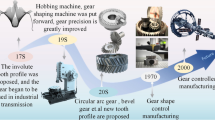Abstract
Guided by failure of large-diameter shafts, photoelastic measurements were made of stresses near the inboard ends of keyways containing keys which provided the forces necessary to place the shaft in torsion. Tensile-stress concentrations not previously reported were found at or near the inboard ends of these keys and keyways. The locations and magnitudes of these stress concentrations correlate well with fractures which have been found to begin at or near these same locations in large marine and compressor shafts.
Similar content being viewed by others
Abbreviations
- K :
-
stress-concentration factor
References
Filon, L. N. G., “On the Resistance of Certain Forms of Shafting with Special Reference to Keyways,”Phil. Trans. R. Soc., London,193,Series A,369 (1900).
Moore, H. F., “The Effect of Keyways on the Strength of Shafts,” Engrg. Exp. Sta. Univ. of Illinois, Bulletin 42 (1910).
Griffiths, A. A. and Taylor, G. I., “Application of Soap Films to the Determination of the Torsion and Flexure of Hollow Shafts,” Rep. Memo. Advis. Comm. Aero., (392) (1918).
Gronwall, A., “Torsion of Circular Shaft with Keyway,”Trans. ASME,20,234 (1919).
Gough, H. J., “The Effect of Keyways upon the Strength and Stiffness of Shafts Subjected to Torsional Stresses,” Aero. Res. Council Tech. Rep.,488 (1924).
Shepard, W. M., “The Torsion and Flexure of Shafting with Keyways and Cracks,”Proc. R. Soc., London,138,Series A,607 (1938).
Okubo, H., “On the Torsion of a Shaft with Keyways,”Quar. Jnl. Mech. Appl. Math.,3,part 2,162 (1950).
Leven, M. M., “Stresses in Keyways by Photoelastic Methods and Comparison with Numerical Solution,”Proc. SESA,VII,141 (1950).
Nakazawa, H., “On the Torsion of the Shaft with Keyways,” Mem. Fac. Tech. Tokyo Metro. Univ.,1 (6) (1956).
Nisida, M. and Hondo, H., “On the Stress Concentrations due to Keyways,” Proc. 9th Jap. Nat. Cong. Appl. Mech., 129 (1959).
Paul, A. K., “Stress-Concentration Factors for Rectangular Keyways in Shafts under Pure Torsion,”J. Instn. Engrs., India,47,100 (1967).
Fessler, H., Rogers, C. C. andStanley, P., “Stresses at End-Milled Keyways in Plain Shafts Subjected to Tension, Bending, and Torsion,”Jnl. Strain Anal.,4,180 (1969).
Peterson, R. E., “Fatigue of Shafts Having Keyways,”Proc. ASTM,32,part 2,413 (1932).
Solakian, A. G. andKarelitz, G. B., “Photoelastic Study of Shearing Stresses in Keys and Keyways,”Trans. ASME,54,97 (1932).
Gibson, W. H. H. and Gilet, P. M., “Transmission of Torque by Keys and Keyways,” J. Inst. Engrs., Australia,10 (1938).
Okubo, H., Hosono, K. andSakaki, K., “The Stress Concentration in Keyways when Torque is Transmitted Through Keys,”Experimental Mechanics,8 (8),375–380 (1968).
Dorey, S. F., “Large Scale Torsional Fatigue Testing of Marine Shafts,”Proc. Instn. Mech. Engrs.,159,399 (1948).
Spotts, M. F., Design of Machine Elements, 4th ed., Prentice-Hall, Enginewood Cliffs, N. J., 131 (1971).
Author information
Authors and Affiliations
Rights and permissions
About this article
Cite this article
Orthwein, W.C. Keyway stresses when torsional loading is applied by the keys. Experimental Mechanics 15, 245–248 (1975). https://doi.org/10.1007/BF02319434
Issue Date:
DOI: https://doi.org/10.1007/BF02319434




